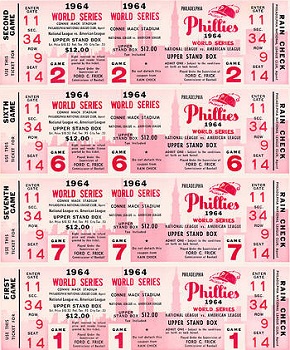 ERIC: Every year about this time, those of us who reside in Phillie Nation are forced to remember the single most painful memory of a franchise that dates back to 1883. Every fall, the Ghost of 1964 rears his ugly head. He’s not welcome in the home of any Phillies fan, but he appears anyway, determined the torment the denizens of Phillies Nation. He also haunted the New York Mets in 2007, but he still lives in Phillies Nation.
ERIC: Every year about this time, those of us who reside in Phillie Nation are forced to remember the single most painful memory of a franchise that dates back to 1883. Every fall, the Ghost of 1964 rears his ugly head. He’s not welcome in the home of any Phillies fan, but he appears anyway, determined the torment the denizens of Phillies Nation. He also haunted the New York Mets in 2007, but he still lives in Phillies Nation.
From 1919 through 1947, the Phillies finished last a total of 17 times and next to last seven times. The 1961 edition of the team—profiled in the book version of You Stink! was one of the worst teams to ever take the field; that team still holds the major league record for most consecutive losses in a season with 23. A 1962 cartoon in a baseball magazine depicted a ballplayer arriving at a French Foreign Legion outpost, declaring, “I was released by the Phillies!” Nobody wanted to be a member of the Phillies.
However, those Phillies teams had Gene Mauch as their manager. Mauch, hired to manage the team in 1961 at the young age of 35, was known as the father of small ball. He was known for squeezing runs out of simple fundamental plays such as bunts, sacrifice flies, hit and run plays, and the like. His teams were known for good pitching, solid defense, and good fundamentals. Although Mauch never won a World Series, he is considered to be one of the most influential managers in the history of the major leagues.
Mauch surrounded himself with some solid talent. Outfielder Johnny Callison, who had movie star good looks, had developed into an excellent player. Center fielder Tony Gonzalez played good defense and blossomed into a .300 hitter. Popular second baseman Tony Taylor played excellent defense and was a fan favorite. Most importantly, Mauch had two fine starting pitchers. Right-hander Jim Bunning, a future Hall of Famer, was the first pitcher to win at least 100 games in each league. Lefty Chris Short became a reliable and effective starter. Things began to look up for the Phillies.
In 1962, the team went 81-80, posting their first winning season in years. In 1963, they went 87-75 and finished fourth. 1964 looked like it could be a good year for the talented young team.
“We executed better than any team in the league,” Jim Bunning has said about the team. “Moving base runners, turning the double play. We seemed to do everything perfectly.” The Phightin’s won eight of their first ten games that season and spent the first half of the season locked in a pennant race with a San Francisco Giants team filled with future Hall of Famers such as Willie Mays, Willie McCovey, and Juan Marichal.
Then, on June 21, 1964, Father’s Day, Bunning twirled a perfect game against the New York Mets in Shea Stadium. Bunning’s perfecto was only the fifth of the modern era, and the first in the National League in 84 years. Even the Mets fans appreciated the significance of Bunning’s accomplishment: “The Phils won the contest…before 32,904 fans who were screaming for Bunning during the last two innings,” noted a New York sportswriter. “Yesterday’s perfect pitching turned the usually loyal Met fans into Bunning fans in the late innings. From the seventh inning on…Bunning had the crowd…behind him.”
Led by rookie of the year Dick Allen (29 homers and 91 RBI’s), a fine season by Callison (.274, with 31 homers and 104 RBI’s), the Phillies spent 112 days in first place in 1964. Callison also hit a walk-off, game-winning three run homer during the All Star Game that year, permitting the host National League to win the game 7-4. Callison finished second to Ken Boyer of the St. Louis Cardinals in the National League MVP voting for 1964. Bunning posted a 19-8 record that year, with 13 complete games, 5 shutouts, and even 2 saves. Short went 17-9, with 12 complete games and four shutouts. Short also had 2 saves. Reliever Jack Baldschun had 21 saves and a fine 3.14 ERA, but Mauch lost confidence in him.
That summer, started Dennis Bennett began having arm trouble. That arm trouble cost the Phillies the National League pennant in 1964. “My arm started bothering me then and they couldn’t find out why,” Bennett recalled. “They took X-rays and they did this and they did that. On road trips, in every town I went to, I would go to see their top physicians. I even went to the Mayo Clinic and they couldn’t find anything wrong. I was still pitching but I couldn’t throw that good really. It hurt so much.”
In September, Bennett had a three-game stretch where his arm felt normal, beating the Dodgers 5-1 and the Giants 1-0 in back-to-back complete games. He then defeated the Houston Colt 45s 1-0 with a little help from closer Jack Baldschun. Then, Bennett’s arm started to really hurt. That prompted Mauch to employ a two-man starting rotation of Bunning and Short, and the two workhouses inevitably wore out.
On September 20, 1964, Bunning tossed a five-hitter and defeated the Dodgers, 3-2 (both runs were unearned and the result of an error by Vic Power). The victory gave the Phillies a 6 1/2 game lead with 12 games to play. The Phils looked like a lock. The team had already printed and begun selling World Series tickets.
Then the Reds came to town. With the teams deadlocked in a 0-0 tie in the 7th inning, Reds back-up infielder Chico Ruiz was on third base. As Phillies hurler Art Mahaffey began his wind-up, Ruiz dashed for home. He should have been out by 20 feet, but the flustered Mahaffey unloosed a wild pitch, and Ruiz scored the game’s only run. Dick Allen said of the play: “The play broke our humps.” The Reds swept the series. Then the Milwaukee Braves swept the next series. And then the St. Louis Cardinals swept the Phillies and moved into first place. The Phils won their last two games, but it was too little, too late. They finished 92-70, tied with Cincinnati. The Cards won the pennant and then the World Series against the New York Yankees.
“The one thing we never got in ’64,” Bunning said, “was the one performance, the one big hit, the one huge pitching performance that could have stopped the bleeding.”
When asked why he stopped using Baldschun as his fireman down the stretch that summer, Mauch coldly replied, “I could see the fear in his eyes.” Baldschun had 21 saves and a 3.15 ERA, but Mauch stopped using him. That, in turn, helped lead to the overworking on Short and Bunning. And the rest, as they say, was history.
Phillies catcher Gus Triandos called 1964 the Year of the Blue Snow, referring to the legend of Paul Bunyan and the fact that something really unusual was going to happen. Triandos had no idea how right he was. What began as a joyous reference still haunts us Phillies fans to this day as we think about that frustrating, horrific collapse. The Phils went 86-76 in 1965 and 87-75 in 1966 before a long, slow descent sunk in. Eight long years and a lot of very bad baseball passed before the Phillies finally had another winning season in 1975 before they won three straight National League Eastern Division titles in 1976, 1977, and 1978, and then their first World Series championship in 1980.
Mauch tried to keep it all in perspective. “People don’t realize what a great year it was,” the late manager Gene Mauch told USA TODAY in 1989 on the 25th anniversary of the collapse. “They say to me, ‘Oh, what a tough year.’ For 150 games it was the most beautiful year in the world. They were a great bunch of kids. When somebody brings it up about how tough it was for me, I don’t even think about that. I think about how tough it was for a great bunch of young people.” Mauch never did manage a World Series team in his long, Hall of Fame career.
In 1977, my friend Jack Wondowski and I visited a flea market where we often went to buy baseball cards, and while wandering one day, I found a block of four 1964 Phillies World Series tickets that I bought for $2.00. They look just like the ones pictured here, and they hang on the wall of my office taunting me each and every day. We Phillies fans enjoy suffering. It’s who we are.
- Season Summary: 92-70
- Final Rank: 2, GB: 1.0
- Days in First: 112 (last on September 26, counts the days a team played and was in first at the end of the day)
- Most Games over .500: 31 (last on September 17)
- Most Games under .500: never
- Biggest Lead: 7.5 (last on August 23)
- Farthest Behind Leader: 2.5 (last on September 30)
- Longest Winning Streak: 5 (May 29 to June 3, July 2 to July 9, and August 7 to August 12)
- Longest Losing Streak: 10 (September 21 to September 30)
- Most Runs Allowed: 14 (July 18 and September 27)
- Most Runs Scored: 13 (July 23 and August 11)
- Longest Game: 16 innings (August 18 and September 19)
- Times Shutout by Opponent: 11
- Times Opponent Shutout: 17



I’m a die-hard Phillies fan and it all started in 1964. Even though I was just a kid, I still remember many of those games, especially those hard losses in September. However, truth be told, the Cardinals had a far better team that year. Check the stats. The Phillies were better than the Cardinals in only 2 positions: Right Field and, arguably, Third Base. I say arguably because Allen was a great clutch hitter, but Ken Boyer was an outstanding defensive third baseman, whereas Allen was a poor fielder. The Phillies had better Relief Pitching, but the Cardinals had 4 solid Starters and the Phillies had Bunning and Short and that’s pretty much it. The Phillies executed extremely well and I credit that to Gene Mauch, who was a GREAT manager that year until mid-September. He made some bizarre moves that month to “set up” and prolong the swoon and there’s no doubt that the pressure got to him. After all, Philadelphia had NEVER had a World Champion and it was up to him to bring the fans one (I think he knew his team didn’t have the talent). In retrospect, it would have been better to have settled back, pitched a minor-leaguer or two, taken the losses and saved Bunning and Short for when they were rested. The “baseball gods” were also against the Phillies as they had 12 tough games to finish the season, whereas the Cardinals and Reds didn’t (and the fact that they didn’t play EACH OTHER was also key).
Posted by Tim Farrell | March 10, 2013, 1:39 pm